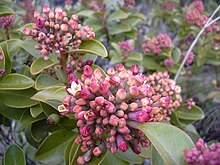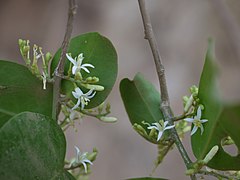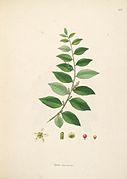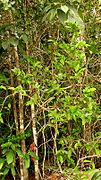Santalales
| Santalales | |
|---|---|

| |
| Santalum haleakalae | |
| Scientific classification | |
| Kingdom: | Plantae |
| Clade: | Tracheophytes |
| Clade: | Angiosperms |
| Clade: | Eudicots |
| Clade: | Superasterids |
| Order: | Santalales R.Br. ex Bercht. & J.Presl[1] |
| Families | |
|
See text | |
| Synonyms | |
|
Balanophorales | |
The Santalales are an order of flowering plants with a cosmopolitan distribution, but heavily concentrated in tropical and subtropical regions. It derives its name from its type genus Santalum (sandalwood). Mistletoe is the common name for a number of parasitic plants within the order.
Overview
[edit]Many of the members of the order are parasitic plants, mostly hemiparasites, able to produce sugars through photosynthesis, but tapping the stems or roots of other plants to obtain water and minerals; some (e.g. Arceuthobium) are obligate parasites, have low concentrations of chlorophyll within their shoots (1/5 to 1/10 of that found in their host's foliage), and derive the majority of their sustenance from their hosts' vascular tissues (water, micro- and macronutrients, and sucrose).
Most have seeds without testae (seed coats), which is unusual for flowering plants.
Classification
[edit]The APG IV system of 2016 includes seven families.[2] As in the earlier APG III system, it was accepted that Olacaceae sensu lato was paraphyletic but new family limits were not proposed as relationships were considered uncertain.[3][2] As of July 2021[update], this seven-family division of the Santalales was explicitly accepted by the World Flora Online,[1] and implicitly by Plants of the World Online, in that it accepted none of the extra families recognized by other sources. The seven families are:
When only these families are recognized, one possible phylogenetic relationship among them is shown below. Support for some of the nodes is weak,[4] and at least two families, Olacaceae s.l. and Balanophoraceae s.l., are not monophyletic:[4][5]
| Santalales |
| ||||||
A summary of the circumscription and phylogeny of the Santalales published in 2020 used 20 rather than seven families. Olacaceae s.l. was divided into seven families, Balanophoraceae s.l. was divided into two, and Santalaceae s.l. into seven.[5] As of July 2021[update], the Angiosperm Phylogeny Website accepted the families resulting from the division of Olacaceae s.l. and Balanophoraceae s.l. but not those from the division of Santalaceae s.l.[4]
|
|
|
Earlier systems
[edit]In the classification system of Dahlgren, the Santalales were in the superorder Santaliflorae (also called Santalanae). The Cronquist system (1981) used this circumscription:[6]
- order Santalales
- family Medusandraceae – sole genus Medusandra now in family Peridiscaceae,[7] order Saxifragales[2]
- family Dipentodontaceae – now in order Huerteales in APG IV[2]
- family Olacaceae
- family Opiliaceae
- family Santalaceae
- family Misodendraceae
- family Loranthaceae
- family Viscaceae - sunk into Santalaceae s.l. in the seven-family system
- family Eremolepidaceae - sunk into Santalaceae s.l. in the seven-family system
- family Balanophoraceae
Gallery of type genera
[edit]References
[edit]- ^ a b "Santalales R.Br. ex Bercht. & J.Presl". World Flora Online. Retrieved 2021-07-20.
- ^ a b c d Angiosperm Phylogeny Group (2016). "An update of the Angiosperm Phylogeny Group classification for the orders and families of flowering plants: APG IV". Botanical Journal of the Linnean Society. 181 (1): 1–20. doi:10.1111/boj.12385.
- ^ Angiosperm Phylogeny Group (2009). "An update of the Angiosperm Phylogeny Group classification for the orders and families of flowering plants: APG III". Botanical Journal of the Linnean Society. 161 (2): 105–121. doi:10.1111/j.1095-8339.2009.00996.x. hdl:10654/18083.
- ^ a b c Stevens, P.F. "Santalales". Angiosperm Phylogeny Website. Retrieved 2021-07-20.
- ^ a b c Nickrent, Daniel L. (2020). "Parasitic angiosperms: How often and how many?". Taxon. 69 (1): 5–27. doi:10.1002/tax.12195.
- ^ Cronquist, A. (1981). An integrated system of classification of flowering plants. New York: Columbia University Press. ISBN 978-0-231-03880-5.
- ^ "Medusandra Brenan". Plants of the World Online. Royal Botanic Gardens, Kew. Retrieved 2021-07-20.
- Hawksworth, FG (1996). Dwarf mistletoes : biology, pathology, and systematics. USDA For. Serv. Agric. Handb. p. 409.
- Soltis, Douglas E.; Soltis, Pamela S.; Endress, Peter K.; Chase, Mark W. (2005-06-15). Phylogeny & Evolution of Angiosperms. Sinauer Associates. p. 370. ISBN 978-0-87893-817-9.
- Santalales on the Parasitic Plant Connection web page
- NCBI Taxonomy Browser








